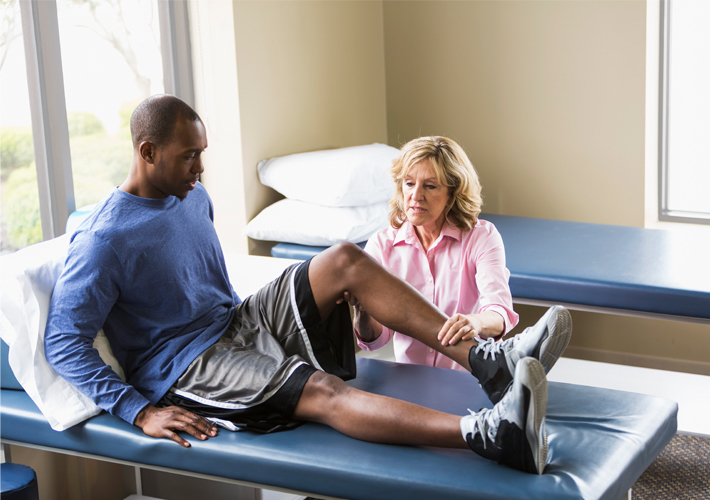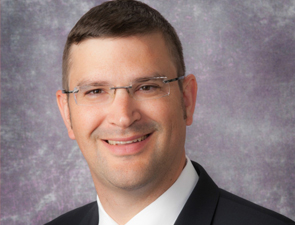
How Joint Replacement Outcomes Are Improved by Modern Research – Interview
Dr. Kenneth Urish, Ph.D., is an adult reconstructive and arthroplasty orthopedic surgeon as well as a member of the committee on medical and surgical materials and devices (F04). He spoke to Standardization News about his innovative work as a researcher, clinician, and engineer. Whether tackling difficult infections that hinder joint replacement patients, or pioneering techniques in robotic surgery, Urish is confronting basic and applied science questions alike – while contributing to standardization along the way.

Can you start by telling me about your career as a practitioner and researcher?
I am an orthopedic surgeon who spends about half of my time in the lab developing new technology. The other half of my time is in the clinic, in the operating room. I often feel that 100% of my time is spent in the lab and 100% of my time is spent in the clinic. My surgical practice is hip and knee joint replacement. My lab is sponsored by the National Institutes of Health (NIH) and is focused on infections with biomedical implants. Joint replacements are one of the most common surgical procedures in the world. The most common reason joint replacements fail is because of infection. Being an engineer that likes to solve problems, my research is focused on asking: Why is it so difficult to get rid of these infections? Are there better solutions for treating them when they come up?
READ MORE: The Next Era of Medical Devices – New Issue
One third of our lab is focused on the basic science mechanism for why it’s so difficult to get rid of these infections. Another third is focused on looking at outcomes with joint replacements in terms of “How can we do a better job?” The final third is focused on how we can apply what we learn in the lab in the clinic. Currently, we’re involved in three different FDA studies, taking technology that we’ve helped develop in the lab and bringing it into the clinic. Standards become very important to address these problems and design clinical studies that test solutions.
Can you tell me about your research into infection? One key bit of context has to do with your interest in antibiotic-tolerant forms of bacteria.
This is a really interesting concept. When a cleaning product talks about killing 99.9% of bacteria, they are talking about platonic bacteria. When you culture bacteria, you can either do it what we call platonically, when it is floating around in solution, or you can do it as a biofilm. A biofilm is a three-dimensional structure, and a certain population of that biofilm is metabolically dormant. If it’s not growing, it doesn’t matter how much penicillin is around; there’s nothing to metabolically disrupt. In the end, 10% of the biofilm might stick around. But as soon as you remove the antibiotic, the bacteria can double in 30 minutes to an hour. You are back to your original population very quickly.
The first question almost every patient asks is “Why can’t I just take an antibiotic?” If the biofilm is antibiotic tolerant, it doesn’t matter how much antibiotic we give. You will need to have surgery, and there are two options. The first one is called debridement, antibiotics, and implant retention (DAIR). I go in there and remove as much of the dead tissue or non-viable stuff as possible. For the implants that are not set to the bone, I exchange those. Then you get antibiotics for six weeks.
That’s the best-case scenario. The problem with this is that it only works about 50% of the time. If it is a chronic infection or the initial DAIR doesn’t work, the second option for getting rid of these infections is called a two-stage exchange, where you remove the implants and put a spacer in there to hold the space. After six weeks of antibiotics, I give your new implants back.
If I told you with surgery and antibiotics, your success rate was 50%, that is not acceptable. That’s what pushed me into the lab. We currently have three FDA studies. One of them is on a new class of broad-spectrum antibiotics. It will be the first new class of antibiotics since carbapenems in the 1980s. They finished up their phase one FDA study, and they’re now preparing for FDA phase three. A second one is on a way to do a rapid two-stage exchange that is finishing phase three. The third study is where we do work with bacteriophages.
Another key aspect of your lab’s research is robotic surgery. Can you tell us about this area of your work?
When I talk to a patient about doing a knee replacement robotically, I see this look come across their face. But I explain this isn’t like the robot from Lost in Space, waving its arms around in the operating room. Robotic surgery is a bit of a misnomer. What this is really about is quantifying the soft-tissue balance. A knee replacement is more like cabinetry then broad carpentry. It’s a surgery of millimeters, so precision counts.
I look at robotics as an extension. It’s a different way to quantify what I’m doing with my manual instrumentation. If I’m doing a surgery with manual instrumentation, I jokingly refer to the jigs and the spacer blocks that I use as the robot, because I’m measuring what I’m doing very precisely. When I go to the robot, the only difference now is that it allows me to fine-tune what I am doing. It’s just a different way to measure outcomes.
READ MORE: Medical Exoskeletons, A Transformative Technology
One of the big clinical studies we’re working on right now is investigating whether there are differences between manual knee replacements and robotic knee replacements. This has been a very difficult thing to demonstrate because manual instrumentation is very good. We also helped develop a surgical technique that went through FDA approval to do robotic surgery for revision knee replacements. Revision knee replacements are a new level of difficulty, because you need to remove implants and put new implants in.
What led you to become involved with ASTM International?
When I was a resident, I became involved with the American Academy of Orthopedic Surgery (AAOS), the main professional organization for orthopedic surgeons. There were a bunch of committees, and one was the biomedical engineering committee. Part of its existence was based on being the end user representation at ASTM meetings. I had no idea what I was getting into.
Very quickly you realize how pivotal ASTM is. The further I went along in my training and then in my career, the more I appreciated how ASTM set the stage to allow different innovations from orthopedic implant companies and how much of a tool those standards were for advancing our field. From a surgical perspective, there are all the ASTM standards and the knowledge base that’s been developed over the last few decades. It provides strong confidence that something should work well.
Your work is fascinating because it sits at the nexus of standards, medicine, and engineering.
I talk to engineers at different companies about this all the time. They don’t appreciate how unbelievably impactful their job is. They might see a very small piece of the overall process. I have the best job because I see the finished product. My very first patient was someone whose hip arthritis was so bad they couldn’t walk anymore. In the last month, they were in a nursing home. I did a hip replacement and two weeks later they’re back in my clinic walking. They said it was a miracle. I said, “No, it’s not a miracle. It’s really good engineering.”
From an engineering perspective, joint replacements are an incredible success story. They started 50 years ago and were only used when the other option was being confined to a wheelchair. After surgery, patients were in the hospital for a month. Today, it’s rather commonplace, and 80% of my joint placements leave that afternoon. The reason we’ve been able to have these improvements is there is an entire field getting together, shaving little pieces of the problem away and making incremental improvements to how we do things. I think standards are responsible for the results we’ve developed along the way.
Why did you choose to follow this career path?
I’ve always been very interested in translational research and a career as a physician. As an undergrad at Penn State, my major was chemical engineering, but I knew that I was heading to medical school. I was very fortunate to be accepted into what the NIH calls a Medical Scientist Training Program (MSTP), where your medical school tuition is funded if you get a Ph.D. I happened to end up in an orthopedics lab. I joke around with medical students that if you bring someone with an engineering background into a joint-replacement operating room, it’s like shooting fish in a barrel. Joint replacements are a body part that has been built, designed, assembled, and put in to replace a joint. ■
Dr. Kenneth Urish, Ph.D., is associate professor at the University of Pittsburgh; associate medical director of Magee Bone and Joint Center; and director of the Arthritis and Arthroplasty Design Laboratory. He is chair of the F04 subcommittee on human clinical trials (F04.39), a member of the subcommittees on arthroplasty (F04.22), and a member of three of the subcommittees for TEMPs (F04.41, F04.42, F04.43).
JP Ervin is content editor of Standardization News.
 SN Home
SN Home Archive
Archive Advertisers
Advertisers Masthead
Masthead RateCard
RateCard Subscribe
Subscribe Email Editor
Email Editor